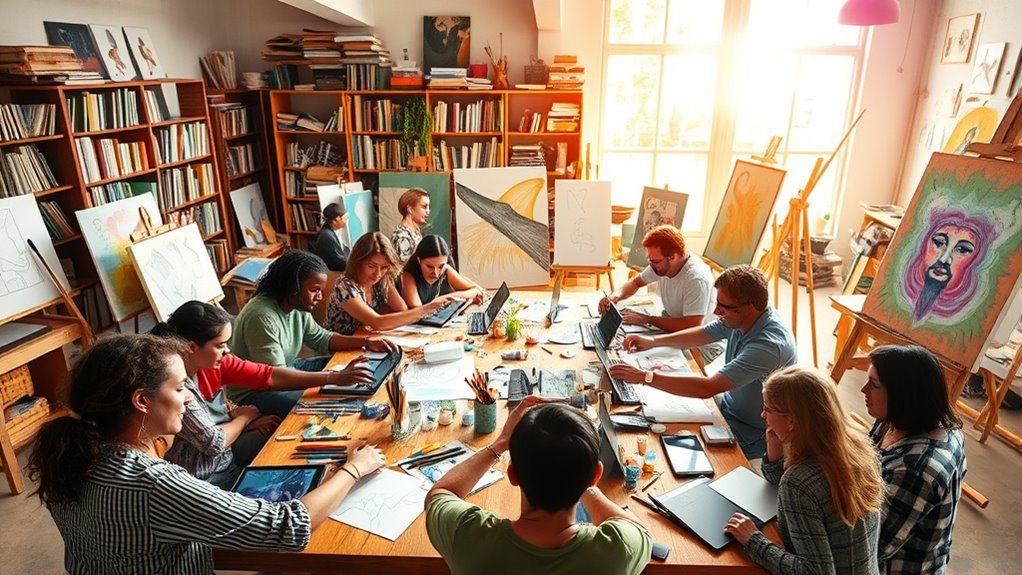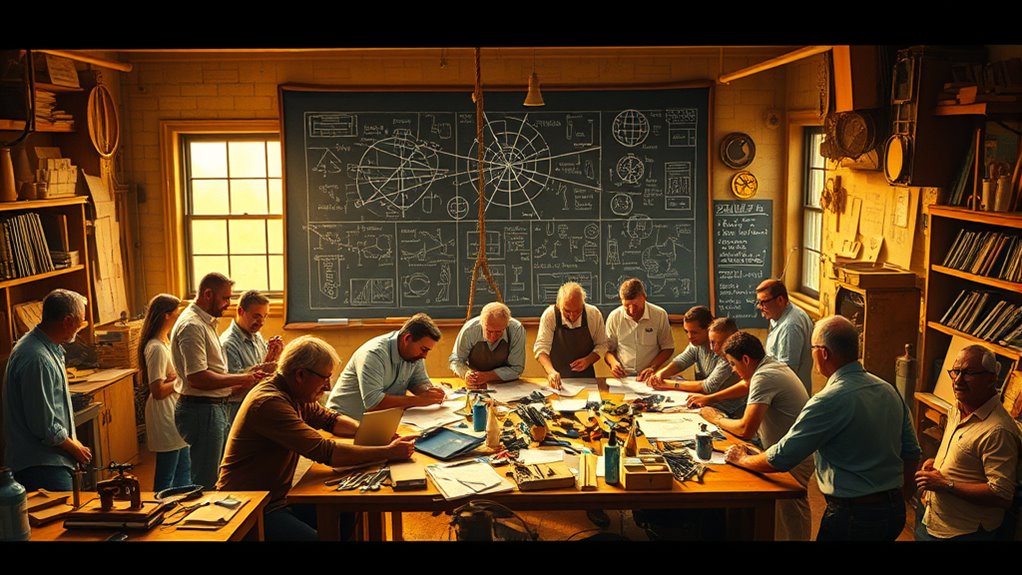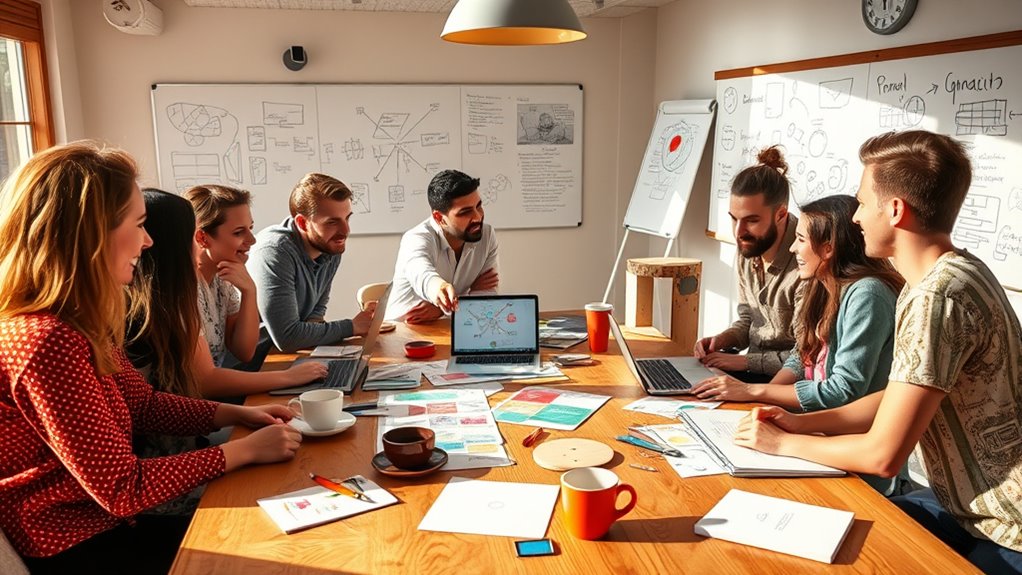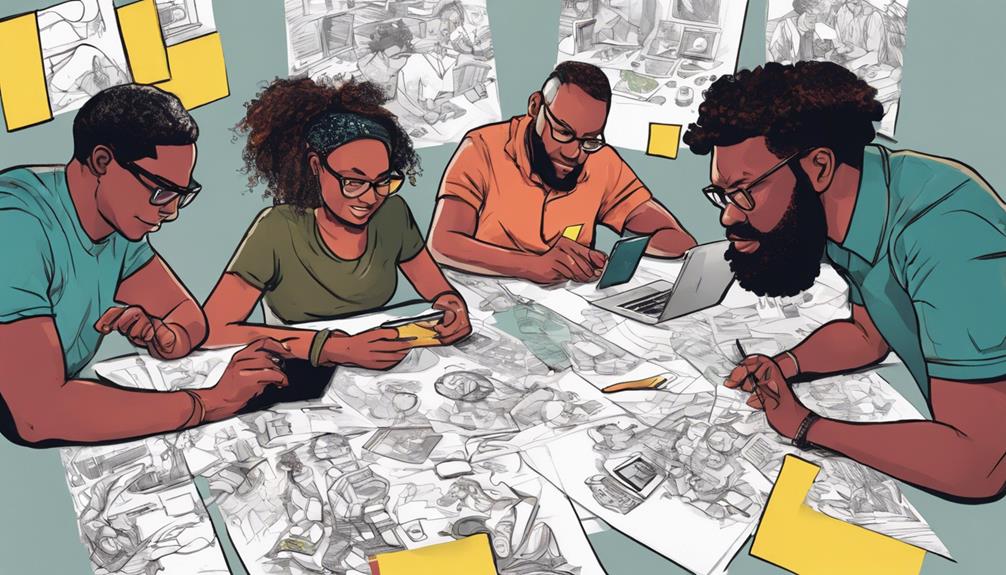The myth of the lone genius suggests that innovation comes from individual efforts, but in reality, collaboration drives progress. Breakthroughs like vaccines and scientific discoveries result from shared knowledge, teamwork, and diverse perspectives. Throughout history, collective efforts have accelerated innovation far beyond what one person could achieve. By working together and embracing a collaborative mindset, you can open creativity and solve complex problems more effectively. Keep exploring to see how collaboration shapes the future of innovation.
Key Takeaways
- Innovation is a cumulative process driven by shared knowledge and collaborative efforts, not just individual genius.
- Historical breakthroughs like the polio vaccine and Human Genome Project highlight team-based collaboration.
- Modern innovation relies on interdisciplinary teamwork, open source sharing, and collective problem-solving.
- Emphasizing collaboration accelerates progress and fosters diverse perspectives, moving beyond the lone genius myth.
- Cultivating a collaborative mindset enhances creativity, idea flow, and team harmony, boosting overall innovation.
Challenging the Myth of Individual Brilliance

Many people believe that groundbreaking innovations come from solitary geniuses working alone, but this idea oversimplifies how real progress happens. While some sole inventors gain recognition, their individual effort is often supported by existing knowledge, resources, and collaborations. Innovation rarely occurs in isolation; it’s a cumulative process fueled by shared ideas and collective input. An example of this is the development of cybersecurity measures, which rely heavily on collaborative efforts among experts worldwide to identify and address vulnerabilities. Recognizing the collaborative nature of invention doesn’t diminish the achievements of sole inventors but highlights that even the most celebrated breakthroughs are part of a larger network. Embracing this perspective helps us understand that progress is rarely the work of one person, but a product of interconnected efforts.
Historical Examples of Collective Innovation

Throughout history, some of the most transformative innovations emerged from collaborative efforts rather than isolated genius. Think of the development of the polio vaccine, where teams of scientists shared ideas and built on each other’s work. The Manhattan Project demonstrates how team networks brought together top minds, combining expertise to achieve a common goal. The Human Genome Project is another example, relying on global collaboration and idea sharing among researchers worldwide. In each case, breakthroughs didn’t come from a single individual but from collective efforts that harnessed diverse skills and perspectives. These examples highlight how collaborative innovation accelerates discovery, proving that groundbreaking achievements often result from shared knowledge and teamwork. Your understanding of history should now recognize the power of collective effort over individual brilliance.
The Role of Collaboration in Scientific Breakthroughs

Collaboration often serves as the catalyst for scientific breakthroughs, enabling you to combine expertise, share diverse perspectives, and address complex problems more effectively. Interdisciplinary teamwork breaks down silos, allowing specialists from different fields to approach challenges with fresh insights. Open source projects exemplify this collaborative spirit, fostering transparency and collective problem-solving that accelerates innovation. By working across disciplines and sharing knowledge freely, researchers can build on each other’s ideas, avoid redundant efforts, and develop holistic solutions. This cooperative approach not only enhances creativity but also widens the scope of possible breakthroughs. Additionally, understanding the vetted nature of resources and products ensures safety and efficacy in collaborative efforts. Ultimately, collaboration transforms individual efforts into powerful, collective progress, proving that scientific advances are rarely the result of isolated genius alone.
How Modern Innovation Differs From the Solo Genius Narrative

Modern innovation increasingly relies on interconnected teams and shared knowledge rather than on isolated flashes of genius. You’ll find that brainstorming techniques foster diverse ideas, encouraging collaboration within creative environments. Instead of waiting for a single bright idea, teams build on each other’s insights, accelerating progress. Modern research and development emphasize cross-disciplinary approaches, where collective input drives solutions. This shift highlights the importance of open communication and dynamic problem-solving. Creative environments nurture trust and facilitate the exchange of expertise, making breakthroughs more achievable through shared effort. Unlike the solo genius myth, today’s innovation thrives on interconnected minds working together, demonstrating that collaboration is the real catalyst for meaningful progress. Effective collaboration solutions play a crucial role in this collective process, shaping the future of innovation.
Embracing a Collaborative Mindset for Future Creativity

Adopting a collaborative mindset is essential for opening future creativity, especially as complex problems demand diverse perspectives and shared expertise. When you focus on team dynamics, you foster an environment where ideas flow freely and innovation thrives. Recognizing that creative synergy emerges from combining different skills and viewpoints allows you to discover fresh solutions. Embrace open communication, active listening, and mutual respect to strengthen your team’s cohesion. By valuing each member’s contributions, you create a space where collaboration sparks new insights and breakthroughs. Understanding the importance of essential oils for collaborative well-being can also enhance team harmony and productivity. This mindset shift helps you move beyond the myth of the lone genius, enabling collective creativity to flourish and leading to more impactful, innovative outcomes for future challenges.
Frequently Asked Questions
How Does Teamwork Influence Individual Creative Recognition?
Teamwork impacts your creative recognition by shaping shared credit and recognition dynamics. When you collaborate, your contributions become part of a collective effort, which can sometimes make individual recognition less clear. However, it also highlights the importance of teamwork in achieving innovative results. You benefit from diverse ideas, but you need to navigate recognition dynamics carefully, ensuring your efforts are acknowledged while appreciating the shared success with others.
What Are the Psychological Effects of Collaborative Versus Solo Work?
When you work collaboratively, your individual motivation can either boost creativity or diminish if groupthink takes over. You might feel more inspired and supported, but there’s also a risk of conforming and losing unique perspectives. Solo work often fosters independence and clarity, yet it can lead to isolation. Understanding these psychological effects helps you navigate and optimize your creative process, balancing teamwork benefits with personal innovation.
Can Collaborative Environments Hinder or Enhance Innovation?
You might find that collaborative environments can enhance innovation by bringing diverse perspectives, leading to creative solutions. However, you should also be aware of groupthink pitfalls, which can suppress dissent and limit originality. Embracing diversity advantages helps avoid these pitfalls, fostering open dialogue and fresh ideas. When managed well, collaboration boosts innovation, but without careful oversight, it could hinder progress through conformity and lack of critical thinking.
How Do Cultural Differences Impact Collective Creativity?
You’ll find that cultural differences greatly impact collective creativity through cross-cultural synergy and diversity dynamics. When you embrace varied perspectives, you foster innovative ideas and problem-solving approaches. However, misunderstandings or differing communication styles can challenge collaboration. By actively valuing cultural diversity and encouraging open dialogue, you create an environment where diverse insights fuel creativity, leading to richer, more innovative outcomes.
What Tools Best Facilitate Effective Collaboration in Creative Projects?
You should prioritize tools that enhance digital collaboration and support brainstorming techniques. Platforms like Miro, Trello, or Google Workspace enable real-time idea sharing and organized teamwork, making it easier to develop creative projects collectively. These tools foster open communication, streamline feedback, and keep everyone engaged, ensuring your team can effectively harness diverse perspectives and ideas—key ingredients for innovative, successful collaborations.
Conclusion
So, you see, the myth of the lone genius is just that—a myth. Real innovation blossoms from collaboration, where countless minds weave together to create something extraordinary. Embracing teamwork unleashes ideas more powerful than you can imagine—like a storm of brilliance that reshapes the world. By shifting your mindset to value collective effort, you’ll tap into limitless creativity and become part of a legacy far greater than any individual alone.









